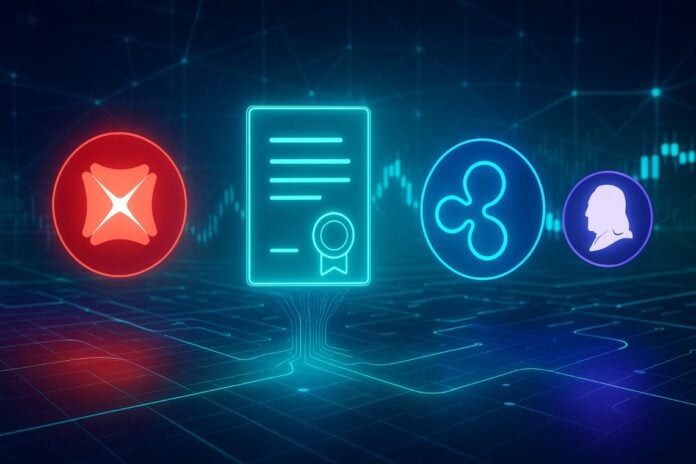A new strategic alliance between DBS, Franklin Templeton, and Ripple brings tokenized lending into the institutional perimeter. Tokenized money funds, such as the sgBENJI token, are used as collateral to unlock real-time credit on the XRP Ledger. This enables 24/7 trading with low operational costs. The initiative was outlined in an official statement published by DBS and also documented in the Ripple press release.
According to data collected by our digital market analysis team and public XRPL metrics, the average settlement times on the network are in the range of a few seconds (typically 3–5 seconds), and the fees per single transaction have historically been very low, often negligible in terms of US dollars. Industry analysts monitoring pilot projects report that the introduction of tokenized assets for collateral can reduce reconciliation times and manual steps by up to 40–60% in contexts with integrated automation. The reported observations refer to available data and tests updated as of September 18, 2025.
Summary
What was announced: sgBENJI, RLUSD and 24/7 trading
The parties have signed a Memorandum of Understanding to integrate stablecoin and tokenized money funds into a single flow within the ledger. DBS Digital Exchange (DDEx) plans the listing of sgBENJI – the tokenized version of the Franklin Templeton US Dollar Short‑Term Money Market Fund – alongside RLUSD (Ripple USD).
Trades between RLUSD and sgBENJI will occur natively on the XRP Ledger, chosen for its low fees and rapid settlement. The goal is to ensure continuous market access and reduce liquidity frictions during hours not covered by traditional financial systems.
Tokenized Loans: What Changes for Institutional Liquidity
Tokenized loans allow for the immediate mobilization of capital by using tokenized funds as collateral. Institutions can alternate between stablecoins and money market funds with traceable and regulated movements in just a few steps, improving treasury management and enabling the issuance of credit against on-chain assets without an immediate conversion to fiat currency. That said, the value also lies in the reduction of operational frictions compared to traditional channels.
sgBENJI as collateral: 3 key mechanisms
- Repo with the bank: repurchase agreements between the client and DBS, with sgBENJI held as collateral while liquidity is provided according to prudential parameters.
- Third-party lending platforms: loans provided by institutional lenders, with DBS acting as the collateral agent and managing segregated collateral.
- On-chain liquidity: credit lines activated directly on XRPL to avoid conversion friction and optimize settlement times.
Technology: Why XRP Ledger for Tokenized Money Funds
Franklin Templeton will issue sgBENJI on the XRP Ledger to leverage the network’s rapid confirmations and low costs. The model allows continuous, 24/7 exchange between stablecoin and tokenized money funds, making the transfer of value instant and verifiable. In this context, the transparency of the ledger facilitates audits and reconciliations; for technical details on the operation and confirmation times, refer to the official documentation of XRPL and the institutional page of Franklin Templeton.
How trades occur in practice
Orders are executed and settled on the XRPL in very short times, ensuring end-to-end visibility of the operational cycle. This facilitates portfolio rebalancing and the capture of money market fund yields, even during phases of high market volatility. Yet, the perceived simplicity relies on rigorous operational pipelines.
Why It Matters to the Market: Signals and Numbers
The demand for regulated on‑chain products is constantly growing. A recent survey conducted by Coinbase and EY‑Parthenon found that 87% of institutional investors plan to allocate funds in digital assets in the near term. Indeed, compatibility with risk management processes is fueling operators’ interest.
- Greater on-chain liquidity for treasury operations and collateral management.
- Credit scalability without complex banking iterations, thanks to ex-ante risk and custody checks.
- Progress towards near real-time cross-border settlement with tokenized assets.
Risks and Regulation: What to Monitor
- Counterparty and custody: lack of asset segregation solutions and the need for independent collateral assessments.
- Prudential requirements: the regulatory treatment of tokenized collateral must establish clear rules for capital and liquidity coverage.
- Stability of RLUSD: transparency on reserves, audits, and governance of the stablecoin will be crucial, aspects on which Ripple has already announced further developments to be verified by September 18, 2025.
- 24/7 Operations: incident management and operational continuity, including the adoption of any cut-offs for accounting reconciliations.
- Concentration risk: potential reliance on a single ledger and limited settlement infrastructures.
Context: how it positions itself compared to other initiatives
Numerous institutions are experimenting with tokenized multi-currency deposit solutions and real-time clearing systems. In Asia, both public and private pilot programs are exploring 24/7 settlement networks to reduce reliance on the traditional correspondent banking system. The agreement between DBS, Franklin Templeton, and Ripple fits into this context: on one hand, it introduces tokenized money market funds in the collateral space, and on the other, it accelerates the adoption of on-chain lending with specific regulatory guardrails. It should be noted that the standardization of processes will be crucial for scalability.
What to Expect in the Next Steps
- The listing of sgBENJI on DBS Digital Exchange (DDEx) and the activation of trading pairs with RLUSD.
- Extension of collateralization policies applicable to repo and lending operations on third-party platforms.
- Dissemination and analysis of operational metrics such as volumes, spreads, and average settlement times to validate the business model.
In Brief
The joint initiative by DBS, Franklin Templeton, and Ripple marks a significant step towards institutional adoption of tokenized lending. If the collateralization mechanisms on XRPL prove effective, liquidity management could become faster, more transparent, and continuous, contributing to greater efficiency in global financial markets.




